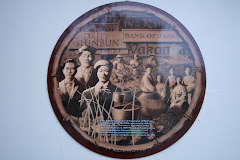 After encountering a myriad of Japanese cultural vignettes over the past three months, I've come to the conclusion that to define that culture is impossible, but here is a brief account of people attempting to do just that in San Francisco's Japantown.
After encountering a myriad of Japanese cultural vignettes over the past three months, I've come to the conclusion that to define that culture is impossible, but here is a brief account of people attempting to do just that in San Francisco's Japantown.It quickly became clear that it depends on who is speaking, and more precisely, what the speaker's age is.
At the risk of oversimplification, there are roughly two camps; one champions the traditional and the other side promotes the new.
"Young people like anime and the older people are more traditional," said Linda Lum, the owner of the Japanese tableware boutique Daikoku by Shiki. "And everything is in Japantown."
Much of the battle between the two culturally divergent paths are brought to life in Japantown and represented by two buildings on opposite sides of Post Street. The 40-year-old Japan Center on the southern side of Post houses shops related to kimonos, taiko, origami, samurai and traditional Japanese cuisine.
New People, on the other hand, is a new building on the northern side of Post Street that features all the latest in Japanese pop-culture.
Even the architectural styles are opposites. New People features a 3-story glass facade that allows the sun to illuminate the inside of the building. The Japan Center shuns natural light and is built with all the stores facing inwards onto sunless halls.
A difference is also visible when comparing the crowds that frequent each location. An older crowd is more prominent in the Japan Center. Meanwhile, on a recent Saturday when New People was opening a new art exhibit -the Tokyo Creators Market- the crowd consisted primarily of younger faces.
Mika Anami, the general manager of Superfrog gallery, was overseeing the opening of the exhibit and reflected on the state of Japanese culture.
She explained that recent Japanese cultural developments mainly originate in Tokyo, a city that is "culturally fast-paced and always changing like New York City on coke," and spread from there. But nothing of what Americans receive is truly authentic, Anami explained, because to be noticed in the U.S. one has to be "big in Japan." New People is trying to change that by importing movies, art and fashion so visitors can catch a glimpse of what's happening in Tokyo.
Many people have picked up on these cultural strands from Tokyo. Every Saturday afternoon cosdancers (people dressed as anime characters that dance) can be seen performing in the Japantown Peace Plaza. Maria Watanabe, an employee at Japan Video and Media in the Kintetsu Mall of Japan Center, consistently appears every Saturday because she wants "to show that Japanese culture is cool and speaking Japanese is cool too."
Takeshi Onishi, Watanbe's boss, organized and integrated the anime portion of the annual Cherry Blossom Festival Parade. He calls anime "a big part of contemporary Japanese culture."
Others aren't so sure. A store that is viewed as most representative of the traditional aspect of Japanese culture, according to Daikoku by Shiki owner Linda Lum, is Dentoh: The Japanese Tradition.

Dentoh, which offers classes in calligraphy, origami, and sells merchandise like papier mache rendtions of traditional Japanese masks, kokeshi (wooden) dolls, traditional kimono and happi coats, is owned by Seiko Fujimoto.
"There's a generation gap," Fujimoto says about the rift over the definition of Japanese culture. And she is appalled by the dancers dressed like anime characters performing their routines underneath the Japantown Peace Pagoda, which she calls "sacred."
Fujimoto also sits on the executive board of the Cherry Blossom Festival, an annual two-week event in San Francisco's Japantown celebrating Japanese heritage, and she does not appreciate the anime portion of the parade.
"Anime is not a part of the culture we want to people to know about," she said. "I think they should make their own festival."
Others, like Linda Lum, may not be interested in anime but understand other's interest, as well as respecting the business aspect of the entertainment.
"I don't mind," Lum said. "[Cosdancing] is entertaining, and if it brings younger people to Japantown and the Cherry Blossom Festival parade that's good for business."
"There's a generation gap," Fujimoto says about the rift over the definition of Japanese culture. And she is appalled by the dancers dressed like anime characters performing their routines underneath the Japantown Peace Pagoda, which she calls "sacred."
Fujimoto also sits on the executive board of the Cherry Blossom Festival, an annual two-week event in San Francisco's Japantown celebrating Japanese heritage, and she does not appreciate the anime portion of the parade.
"Anime is not a part of the culture we want to people to know about," she said. "I think they should make their own festival."
Others, like Linda Lum, may not be interested in anime but understand other's interest, as well as respecting the business aspect of the entertainment.
"I don't mind," Lum said. "[Cosdancing] is entertaining, and if it brings younger people to Japantown and the Cherry Blossom Festival parade that's good for business."




No comments:
Post a Comment